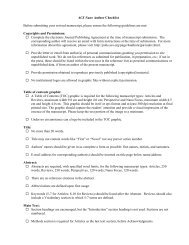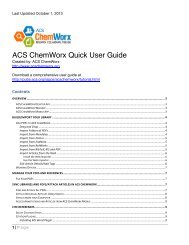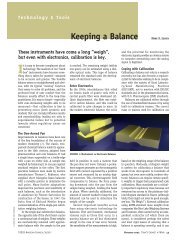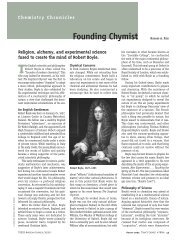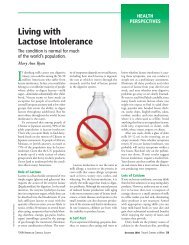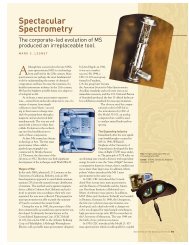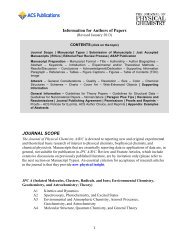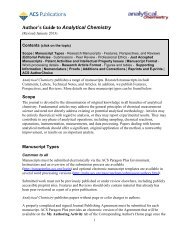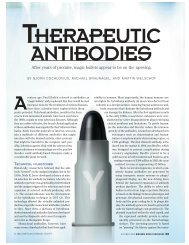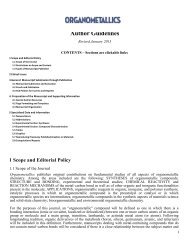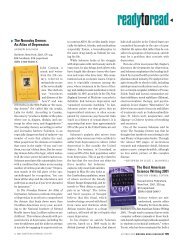Download this story as a PDF - American Chemical Society ...
Download this story as a PDF - American Chemical Society ...
Download this story as a PDF - American Chemical Society ...
Create successful ePaper yourself
Turn your PDF publications into a flip-book with our unique Google optimized e-Paper software.
COURTESY OF GEORGIA INSTITUTE OF TECHNOLOGY<br />
C<br />
hemists who are ready<br />
to enter the workforce or change<br />
jobs—and who are hoping that<br />
the industry h<strong>as</strong> finally made a<br />
recovery and is hiring in earnest<br />
again—may be disappointed in the coming<br />
months. Many of the industry representatives<br />
and university chemistry department heads<br />
C&EN talked to about the 2005–06 hiring<br />
se<strong>as</strong>on said they predicted hiring levels for<br />
new chemists will roughly mirror those of l<strong>as</strong>t<br />
year or be slightly reduced. That’s not good<br />
news, <strong>as</strong> l<strong>as</strong>t year’s employment situation<br />
showed little sign of recovery from the<br />
prolonged downturn that h<strong>as</strong> been affecting<br />
chemical hiring for years now.<br />
It’s still early in the hiring se<strong>as</strong>on, though,<br />
and a number of factors complicate <strong>this</strong><br />
year’s hiring forec<strong>as</strong>ts. Economic and political<br />
events, for example, have buffeted<br />
an already beleaguered chemical industry.<br />
Dr<strong>as</strong>tic incre<strong>as</strong>es in the price of petroleum<br />
products have sent feedstock, material, and<br />
transportation costs skyrocketing, and a record-breaking<br />
hurricane se<strong>as</strong>on h<strong>as</strong> made<br />
things worse by battering manufacturing<br />
COVER STORY<br />
LITTLE CHANGE IN HIRING<br />
FOR NEW GRADUATES<br />
Many recruiters say efforts will resemble l<strong>as</strong>t year’s<br />
depressed levels<br />
A ALOK MEHTA , C&EN WA SHINGTON<br />
facilities and oil production on the U.S. Gulf<br />
Co<strong>as</strong>t. Companies continue to invest heavily<br />
in foreign facilities, lured by inexpensive<br />
labor and production costs.<br />
Even the pharmaceutical industry, which<br />
h<strong>as</strong> traditionally been a huge source of jobs<br />
for chemists, biochemists, and<br />
chemical engineers even in difficult<br />
economic situations, seems<br />
to have slowed its growth in the<br />
face of a number of unique controversies<br />
and dilemm<strong>as</strong>. Fallout<br />
from the Vioxx controversy may<br />
dramatically affect the regulatory<br />
climate for new pharmaceuticals,<br />
making companies skittish about<br />
announcing large hiring incre<strong>as</strong>es.<br />
Uproar over vaccine production<br />
and incre<strong>as</strong>ing prescription drug<br />
costs have deepened public distrust of pharmaceutical<br />
companies. And in an effort to<br />
alleviate the m<strong>as</strong>sive costs of drug research,<br />
pharmaceutical companies continue to contract<br />
research to offshore firms.<br />
All <strong>this</strong> means that chemists looking to<br />
enter the workforce in the coming year will<br />
have a tough time. Most candidates are unlikely<br />
to have multiple job offers, and searches<br />
may take months longer than expected. Yet<br />
not all recruiters C&EN talked with were<br />
pessimistic about the hiring outlook. Petrochemical<br />
companies are doing especially<br />
well, and the forec<strong>as</strong>t for chemical engineers<br />
and bachelor’s- and m<strong>as</strong>ter’s-level chemists is<br />
promising. Other firms will continue to hire<br />
at modest levels to replace their aging workforces,<br />
and some are still expanding their<br />
research capacities significantly.<br />
Strong candidates with expertise in synthetic<br />
organic and medicinal chemistry will<br />
still land coveted positions in the pharmaceutical<br />
industry. And even in difficult circumstances,<br />
most chemists fare decently. The university<br />
representatives C&EN interviewed<br />
said that, on the whole, almost all of their<br />
graduate students and postdocs searching<br />
for jobs l<strong>as</strong>t year ended up finding the kind<br />
of position they were looking for.<br />
At the two largest U.S. chemical companies,<br />
reports are mixed. DuPont predicts that<br />
the recruiting se<strong>as</strong>on will generally be tough<br />
for new graduates, though there will be exceptions.<br />
“This may again be a challenging year<br />
for chemistry, biochemistry, and chemical<br />
engineering grads, due mainly to the uncertainty<br />
in the global economic climate,” says<br />
Senyo Opong, the company’s Ph.D. and science<br />
staffing manager. “<strong>Chemical</strong> engineers<br />
are likely to be the most affected.<br />
“THE UNCERTAIN economy—including the<br />
effects of Hurricanes Katrina and Rita—is<br />
hurting the renewal effort of<br />
most U.S. manufacturing-b<strong>as</strong>ed<br />
companies, and our industry is<br />
no exception,” he adds. “Despite<br />
the uncertain economy, I believe<br />
DuPont is positioned to have a<br />
great recruiting se<strong>as</strong>on. Our science<br />
and technology leadership<br />
is fully committed to science<br />
workforce renewal, particularly<br />
at the Ph.D. level.”<br />
EMPLOYMENT<br />
OUTLOOK<br />
For that re<strong>as</strong>on, “the needs of<br />
DuPont <strong>this</strong> year are similar to<br />
l<strong>as</strong>t year,” Opong says. The company h<strong>as</strong><br />
been hiring more Ph.D.s in the p<strong>as</strong>t few<br />
years, and <strong>this</strong> year will be no exception.<br />
“We are recruiting actively on campus at all<br />
degree levels, including chemists, chemical<br />
engineers, biochemists/biologists, material<br />
scientists, and others,” he says.<br />
“My <strong>as</strong>sessment is that it is a somewhat below-average<br />
job market for new graduates. It’s very uneven in terms<br />
of which companies are hiring and not hiring.”<br />
W W W . C E N – O N L I N E . O R G C & E N / N O V E M B E R 7 , 2 0 0 5 3 5
“The level of experience needed varies<br />
with the job opening,” he adds. The company<br />
is focusing on chemists with backgrounds<br />
in organic chemistry and polymer<br />
chemistry, scientists with synthesis skills,<br />
and analytical and materials chemists and<br />
biochemists. DuPont also h<strong>as</strong> incre<strong>as</strong>ed its<br />
recruiting of chemical engineers, “particularly<br />
those with interdisciplinary skills and<br />
those with process development skills.”<br />
Dow is more optimistic. “Overall, the<br />
job market appears to be strong, with more<br />
companies hiring more graduates than in<br />
the previous couple of years,” says Sarah<br />
Kok, workforce planning specialist for<br />
Dow. “Some companies have announced<br />
extremely large recruiting goals.<br />
“This is a good year to be graduating with<br />
chemistry and chemical engineering degrees,”<br />
she adds. “There are specific business segments<br />
that are experiencing significant growth,<br />
and they will need engineers to support that<br />
growth.” Dow plans to recruit heavily to meet<br />
booming business needs. “Our needs in 2006<br />
are higher due to business growth and also<br />
expected attrition in the next several years,”<br />
Kok says. The company will be hiring mostly<br />
bachelor’s-level scientists, but it will remain on<br />
the lookout for a “fair number” of candidates<br />
with graduate degrees, <strong>as</strong> well <strong>as</strong> some scientists<br />
with work experience.<br />
Traditional chemical companies,<br />
however, are responsible for only a<br />
small portion of chemical hiring.<br />
Pharmaceutical and biotech companies<br />
remain the strongest sectors<br />
hiring chemists, even <strong>as</strong> the segment<br />
faces public controversy and incre<strong>as</strong>ing<br />
pressure to cut costs. But reports<br />
from pharmaceutical representatives<br />
<strong>this</strong> year are also mixed.<br />
“My <strong>as</strong>sessment is that it is a<br />
somewhat below-average job market<br />
for new graduates,” says Hans<br />
Maag, vice president of chemistry<br />
for Roche Palo Alto. “It’s very uneven<br />
in terms of which companies<br />
are hiring and not hiring.<br />
“Company visits on average are<br />
down,” he adds. “It’s very clear that<br />
some companies that have routinely<br />
visited schools have not gone<br />
<strong>this</strong> year.”<br />
But Roche is hiring at a slightly<br />
higher level than it h<strong>as</strong> averaged<br />
over the p<strong>as</strong>t several years, Maag<br />
says. “We are part of a multinational<br />
company. Roche is doing quite well<br />
in the industry, so our situation h<strong>as</strong><br />
not been affected much” by highprofile<br />
controversies in pharmaceuticals,<br />
he says. “We have been well-insulated from<br />
these kinds of events.”<br />
COVER STORY<br />
In particular, the firm is looking for medicinal<br />
chemists and process chemists, both<br />
at the Ph.D. and the bachelor’s/m<strong>as</strong>ter’s<br />
level. Like most pharmaceutical companies,<br />
Roche is looking for candidates with<br />
extensive training in synthetic organic<br />
chemistry. But hiring is slightly down from<br />
l<strong>as</strong>t year, he says, which “w<strong>as</strong> an exceptional<br />
year for us.”<br />
Pfizer echoes many of those sentiments.<br />
“I would cl<strong>as</strong>sify <strong>this</strong> year <strong>as</strong> being fairly<br />
similar to l<strong>as</strong>t year,” says Brian S. Bronk,<br />
director of medicinal chemistry in neurosciences<br />
at the company and head of the<br />
Ph.D.-level organic chemistry recruiting efforts<br />
in the U.S. for Pfizer Global Research<br />
& Development. “But I also see signs that<br />
it’ll be leaner than l<strong>as</strong>t year—overall demand<br />
is not <strong>as</strong> high <strong>as</strong> it w<strong>as</strong>.<br />
“WHAT’S CHANGED is demand from major<br />
pharma,” he adds. Where<strong>as</strong> before, a<br />
single company would have upward of 10<br />
openings, openings are now spread out<br />
over more firms, and candidates will have<br />
to work harder to secure positions. Still,<br />
“there are opportunities for qualified candidates,”<br />
he says. “It just requires more effort<br />
and diligence.”<br />
Pfizer, he says, h<strong>as</strong> a “small number of<br />
openings for chemists at all levels—bach-<br />
HELP WANTED<br />
Academic job postings in C&EN jump, but<br />
industrial openings remain low<br />
Volume of “positions open” advertising, column-inchesa 1,200<br />
Academic<br />
1,000<br />
800<br />
600<br />
400<br />
200<br />
0<br />
2002 2003<br />
2004<br />
Volume of “positions open” advertising, column-inchesa 2005<br />
800<br />
Nonacademic<br />
600<br />
400<br />
200<br />
0<br />
2002 2003<br />
a Column-inches published during consecutive periods of four weeks each.<br />
elor’s, m<strong>as</strong>ter’s, Ph.D.s, and postdocs.” For<br />
Ph.D.s, the company is looking for scientists<br />
with strong synthetic organic chemistry<br />
CHEMICAL ENGINEERS<br />
Downward trend in number of<br />
degrees continues at all levels<br />
BACHELOR’S MASTER’S PH.D.<br />
1982–83 7,185 1,368 692<br />
1983–84 7,475 1,514 409<br />
1984–85 7,146 1,544 504<br />
1985–86 5,877 1,361 531<br />
1986–87 4,991 1,184 584<br />
1987–88 3,917 1,088 685<br />
1988–89 3,663 1,093 712<br />
1989–90 3,430 1,035 658<br />
1990–91 3,444 903 691<br />
1991–92 3,754 956 725<br />
1992–93 4,459 990 737<br />
1993–94 5,163 1,032 725<br />
1994–95 5,901 1,085 708<br />
1995–96 6,319 1,176 798<br />
1996–97 6,564 1,131 767<br />
1997–98 6,319 1,128 776<br />
1998–99 6,033 1,130 674<br />
1999–00 5,807 1,078 725<br />
2000–01 5,611 1,083 728<br />
2001–02 5,462 973 705<br />
2002–03 na na 643<br />
NOTE: Data were collected from degree-granting<br />
institutions. na = not available.<br />
SOURCES: National Center for Education Statistics,<br />
National Science Foundation<br />
backgrounds, while extensive research and<br />
lab experience are essential for B.S.- and<br />
M.S.-level candidates.<br />
Bronk believes candidates looking<br />
for jobs in the pharmaceutical<br />
industry need to be flexible and<br />
adaptable. “The pharmaceutical<br />
industry is facing a new set of challenges,”<br />
he says. “Opportunities<br />
are still going to be there, but the<br />
opportunities are going to be in a<br />
much more dynamic environment<br />
and industry than it used to be. The<br />
pace of change strikes me <strong>as</strong> different<br />
than before.”<br />
At AstraZeneca’s Boston site, “we<br />
will continue our recruiting effort,<br />
at all levels—Ph.D., bachelor’s, and<br />
m<strong>as</strong>ter’s,” says John Primeau, director<br />
and head of infection chemistry<br />
at AstraZeneca R&D Boston. “It<br />
will likely be a similar level of recruiting<br />
<strong>as</strong> l<strong>as</strong>t year.”<br />
The company h<strong>as</strong> settled into a<br />
modest growth pattern after rapidly<br />
expanding some of its core chemistry<br />
groups, such <strong>as</strong> those focusing<br />
on infection and cancer, earlier in<br />
the decade. “We’re growing more<br />
slowly now,” Primeau says, at about<br />
6–7% a year.<br />
The company is looking for synthetic<br />
medicinal chemists, analytical chemists,<br />
informaticians, and computational chemists<br />
3 6 C & E N / N O V E M B E R 7 , 2 0 0 5 W W W . C E N – O N L I N E . O R G<br />
2004<br />
2005
at a range of levels, including some right out<br />
of school and others with experience.<br />
Typically, Primeau adds, AstraZeneca<br />
conducts much of its hiring locally, in the<br />
Boston area. “There’s pretty strong competition<br />
for talent with other pharmaceutical<br />
companies in the area,” he says. “That’s very<br />
good for candidates.” But he adds that he h<strong>as</strong><br />
seen some downsizing locally <strong>as</strong> well.<br />
Novartis also h<strong>as</strong> a pessimistic take on<br />
hiring. “My impression is that <strong>this</strong> will be<br />
a tight recruiting year. There aren’t <strong>as</strong> many<br />
jobs around <strong>as</strong> in the recent p<strong>as</strong>t,” says Scott<br />
Biller, head of global discovery chemistry<br />
for the company. “I’ve even heard of other<br />
companies reducing staff. That’s the general<br />
tenor in the pharmaceutical industry.”<br />
At Novartis, hiring will be<br />
“comparable to l<strong>as</strong>t year,” he<br />
says. “We’ve been growing our<br />
chemistry at a steady pace since<br />
I came to the company in 2003,<br />
and we’ll at le<strong>as</strong>t continue that<br />
in 2005–06.”<br />
The company is looking<br />
to hire scientists at all levels,<br />
though Ph.D.s with postdocs<br />
are preferred. And “we plan to<br />
incre<strong>as</strong>e our experience b<strong>as</strong>e by<br />
also hiring some people with<br />
pharmaceutical company experience,”<br />
Biller adds.<br />
In particular, the company is<br />
looking for scientists with synthetic<br />
organic and bioorganic<br />
backgrounds who can apply<br />
their skills to drug discovery.<br />
They also need some computational<br />
chemists.<br />
Bristol-Myers Squibb is also<br />
not hopeful. “In pharma<br />
in general, research budgets<br />
aren’t growing at the same rate<br />
that they used to,” says Carl P.<br />
Decicco, vice president of discovery<br />
chemistry. “There are<br />
probably fewer jobs available in<br />
the industry <strong>this</strong> year than previous years,<br />
but I can’t say that for certain. The number<br />
of companies recruiting seems to be a<br />
little down.”<br />
He points to a number of factors that<br />
have contributed to the slowdown, including<br />
the rapid consolidation the industry h<strong>as</strong><br />
seen recently. “Organizations are trying to<br />
make strategic decisions on how big their<br />
research groups should be,” he says. “It’ll<br />
take some time to work through, so they’ll<br />
be a little careful and hesitant doing too<br />
much at <strong>this</strong> point.”<br />
Bristol-Myers Squibb will be hiring at<br />
roughly the same rate <strong>as</strong> it did the previous<br />
two years, with a number of positions avail-<br />
able in both its discovery and process chemistry<br />
groups, he says. Though it’s still early, he<br />
adds that he is “very ple<strong>as</strong>ed at the number<br />
of extremely qualified candidates he’s seen at<br />
the Ph.D. and postdoctoral level.”<br />
“THE INDUSTRY is very cyclical,” Decicco<br />
says. “There’s a trend where there’s not a lot<br />
of growth right now. That’s likely to change<br />
<strong>as</strong> the pipeline delivers and there is a reinvestment<br />
in research.” Still, he adds, “there<br />
will always be a demand for highly skilled<br />
synthetic organic chemists in drug development<br />
and research.”<br />
The pharmaceutical industry’s challenges<br />
are also affecting <strong>as</strong>sociated companies, such<br />
<strong>as</strong> contract research firms. “Things are not<br />
JOB HUNT WOES<br />
Number of job openings and employers at ACS’s national<br />
meeting employment centers h<strong>as</strong> plummeted<br />
TOTAL<br />
CANDIDATES EMPLOYERS<br />
POTENTIAL<br />
OPENINGS<br />
<strong>as</strong> rosy <strong>as</strong> they were a year ago,” says Alexander<br />
Chucholowski, vice president for chemistry<br />
at ChemBridge Research Laboratories.<br />
“There’s a lot of uncertainty in our business<br />
and the whole area we’re working in.<br />
“We are providers to the pharmaceutical<br />
industry. If it is hurting, we are hurting,” he<br />
adds. “And it’s very difficult for contract research<br />
organizations operating in the U.S.<br />
That’s reflective of the pharma industry in<br />
general. The industry h<strong>as</strong> problems, and it’s<br />
trying to save money wherever possible, such<br />
<strong>as</strong> sending research overse<strong>as</strong>. Offshoring is<br />
the biggest threat to us.”<br />
For those re<strong>as</strong>ons, ChemBridge is being<br />
especially careful in its hiring plans <strong>this</strong><br />
year. “In previous years, we hired with the<br />
expectation that new business would appear,”<br />
he says. “We will be much more cautious<br />
<strong>this</strong> year.”<br />
The company is looking for new chemists<br />
on a c<strong>as</strong>e-by-c<strong>as</strong>e b<strong>as</strong>is, at all levels. “But it’s<br />
e<strong>as</strong>ier to find qualified Ph.D.s than it is to<br />
find well-trained bachelor’s- and m<strong>as</strong>ter’slevel<br />
candidates,” Chucholowski says. Most<br />
of the Ph.D.s Chembridge hires—upward<br />
of 80%—have postdocs, he adds.<br />
Chucholowski is not completely pessimistic<br />
about the industry, though. “Recently I<br />
have seen more start-up and biotech companies<br />
getting financing. We hope we’ll see<br />
some improvement in business from <strong>this</strong>,<br />
but we’re not sure,” he says. Still, “if the<br />
situation improves, it will take<br />
some time to improve.”<br />
One counterpoint to the modest<br />
hiring plans of many pharmaceutical<br />
companies is Gilead<br />
Sciences. “As a company, we are<br />
rapidly growing,” says Norbert<br />
W. Bischofberger, executive vice<br />
president of research and development.<br />
“We’re investing a lot of<br />
money into research, discovery,<br />
and development.”<br />
In fact, he adds, “one interesting<br />
challenge we’re facing is<br />
that hiring takes time.” Because<br />
the company can only interview<br />
a limited number of chemists,<br />
and integrating new hires into<br />
the team-b<strong>as</strong>ed setting of drug<br />
discovery takes a while, “there’s<br />
a limit on just how many people<br />
you can bring onboard in one<br />
year.”<br />
The company continues to<br />
look for chemists, biochemists,<br />
molecular biologists, and analytical<br />
chemists for drug discovery,<br />
process chemistry, and analytical<br />
formulation. Synthetic organic<br />
chemists are especially<br />
important, Bischofberger says. “They are<br />
the bread and butter of the pharmaceutical<br />
industry.” He adds that Gilead is seeking, to<br />
a lesser extent, chemical engineers.<br />
Gilead h<strong>as</strong> also had trouble attracting<br />
good bachelor’s- and m<strong>as</strong>ter’s-level chemists.<br />
“We’re very interested in finding good<br />
candidates,” he says, “but we have found it<br />
a little more challenging.”<br />
But Bischofberger tempers his company’s<br />
hiring plans with a warning. “There are a lot<br />
of changes going on, with the potential to<br />
affect very greatly the future of the pharmaceutical<br />
industry,” he says. “It’s a changing<br />
environment and political landscape, and<br />
that will affect how much the pharmaceu-<br />
INTERVIEWS<br />
SCHEDULED<br />
2000<br />
San Francisco 1,052 169 1,069 3,367<br />
W<strong>as</strong>hington, D.C. 1,057 156 1,616 3,479<br />
2001<br />
San Diego 897 209 1,429 4,299<br />
Chicago 1,112 169 1,392 4,377<br />
2002<br />
Orlando 867 131 436 3,146<br />
Boston 1,231 137 521 4,688<br />
2003<br />
New Orleans 1,151 96 305 1,751 a<br />
New York City 1,374 97 291 1,673 a<br />
2004<br />
Anaheim 1,281 121 271 1,605 a<br />
Philadelphia b 1,494 107 303 1,602 a<br />
2005<br />
San Diego 1,296 88 189 1,291 a<br />
W<strong>as</strong>hington, D.C. 1,927 97 289 1,685 a<br />
a Figures for interviews scheduled may not be comparable with previous years’ because<br />
of implementation of a computerized registration and communication system. b The National<br />
Employment Clearing House officially became the Chemjobs Career Center beginning<br />
with the Philadelphia meeting. SOURCES: <strong>American</strong> <strong>Chemical</strong> <strong>Society</strong> Department<br />
of Career Services, Chemjobs Career Center<br />
W W W . C E N – O N L I N E . O R G C & E N / N O V E M B E R 7 , 2 0 0 5 3 7
tical industry is willing to invest in research<br />
and development.”<br />
Albany Molecular Research also predicts<br />
a bright recruiting se<strong>as</strong>on. “We primarily<br />
serve the pharmaceutical/biotech<br />
sector,” says Brian D. Russell, the firm’s<br />
CHEMISTRY DEGREES<br />
Most recent data show number of<br />
Ph.D.s jumping significantly<br />
BACHELOR’S MASTER’S PH.D.<br />
1982–83 10,796 1,622 1,758<br />
1983–84 10,704 1,667 1,765<br />
1984–85 10,482 1,719 1,836<br />
1985–86 10,116 1,754 1,903<br />
1986–87 9,670 1,738 1,975<br />
1987–88 9,052 1,708 2,015<br />
1988–89 8,625 1,774 1,970<br />
1989–90 8,132 1,682 2,100<br />
1990–91 8,321 1,665 2,194<br />
1991–92 8,641 1,780 2,214<br />
1992–93 8,914 1,842 2,137<br />
1993–94 9,425 1,999 2,257<br />
1994–95 9,722 2,099 2,162<br />
1995–96 10,415 2,254 2,149<br />
1996–97 10,644 2,240 2,148<br />
1997–98 10,582 2,141 2,216<br />
1998–99 a 10,120 2,037 2,132<br />
1999–00 10,043 1,888 1,989<br />
2000–01 9,493 1,985 1,980<br />
2001–02 9,136 1,845 1,923<br />
2002–03 na na 2,037<br />
NOTE: Data were collected from degree-granting institutions.<br />
a Bachelor’s and m<strong>as</strong>ter’s degree information<br />
estimated from ACS 1999 Starting Salary Survey.<br />
na = not available. SOURCES: National Center for<br />
Education Statistics, National Science Foundation<br />
senior director of human resources. The<br />
growth in that sector provides “a positive<br />
outlook” for Albany Molecular, he adds.<br />
The company will have “an active recruiting<br />
year in the area of organic chemistry,”<br />
Russell says. And talks with other recruiters<br />
have suggested to him that chemical<br />
engineering graduates will enjoy a relatively<br />
strong market.<br />
“OUR CURRENT and expected customer demand<br />
indicates strong hiring trends in 2006<br />
on the chemistry services side,” he adds.<br />
“While we cannot speak for the chemical<br />
industry <strong>as</strong> a whole, we believe our recruiting<br />
situation reflects the confidence in Albany<br />
Molecular from the market we serve, <strong>as</strong> well<br />
<strong>as</strong> current trends in that market.”<br />
The company is planning on hiring chemists<br />
at all degree levels in 2006, including new<br />
graduates and scientists with industry experience.<br />
In particular, he adds, Albany Molecular<br />
is looking for candidates with degrees in or<br />
experience with organic synthesis, analytical<br />
chemistry, and chemical engineering.<br />
Another bright segment for new chemists<br />
and chemical engineers is the petrochemi-<br />
COVER STORY<br />
cal industry. Despite extensive hurricane<br />
damage <strong>this</strong> year and l<strong>as</strong>t year, oil companies<br />
recently posted record profits. Though<br />
<strong>this</strong> irks a public battling dramatic incre<strong>as</strong>es<br />
in the cost of g<strong>as</strong>oline and heating oil, the<br />
windfall may translate into a number of opportunities<br />
for new chemists.<br />
“Higher demand is evident, particularly<br />
in the energy business, where there is an<br />
aging workforce,” says Susan K. Wilson,<br />
manager for recruitment marketing at<br />
BP America. “The current job market is<br />
very competitive for the best in cl<strong>as</strong>s.” Top<br />
chemical engineers are getting multiple offers,<br />
she says, and “all students are enjoying<br />
a lot of attention.”<br />
At BP, “our needs are up about 30%, due<br />
to incre<strong>as</strong>ed needs in exploration and production,”<br />
she says. The company is looking<br />
mostly for B.S.-level chemical engineers, plus<br />
a handful of Ph.D. chemical engineers and<br />
chemists, particularly those with a background<br />
in catalysts. In addition, its refining<br />
technology group is actively searching for<br />
chemists with experience.<br />
The company looks for candidates with<br />
solid technical skills who have demonstrated<br />
creativity and drive. “In addition to strong<br />
academic performance,” Wilson says, “experiential<br />
work, such <strong>as</strong> internships, distinguishes<br />
most higher quality candidates.<br />
Other petrochemical companies have<br />
similar outlooks. “The job market appears<br />
to be very good for chemical engineering<br />
students <strong>this</strong> year,” says Doug Chauveaux,<br />
manager of college relations and staffing for<br />
Chevron Phillips <strong>Chemical</strong>. “We attribute<br />
<strong>this</strong> to three factors: the economic market<br />
conditions in the chemical and petrochemical<br />
industry, the approaching retirement<br />
age of the baby boomer generation, and an<br />
insufficient number of students entering<br />
these disciplines each year.<br />
“Chevron Phillips <strong>Chemical</strong>’s recruiting<br />
situation generally mirrors that of the<br />
chemical industry,” he adds.<br />
The company is actively recruiting B.S.level<br />
chemical engineers in anticipation of<br />
large hiring needs. “When employees retire,<br />
our preference is to promote from within. As<br />
a result, there is a need for qualified graduates<br />
to fill these vacancies,” Chauveaux says.<br />
“In fact, Chevron Phillips <strong>Chemical</strong> expects<br />
to hire more graduates in the next two years<br />
than the total number of new hires in the<br />
company’s previous five years.”<br />
The company also recruits scientists and<br />
engineers with more experience when positions<br />
requiring such expertise open up. Currently,<br />
the company’s joint-venture project in<br />
Saudi Arabia, Jubail Chevron Phillips, h<strong>as</strong> a<br />
need for experienced engineers, he says.<br />
University department heads mirror the<br />
uncertainty of industry representatives over<br />
<strong>this</strong> year’s hiring trends: Many were discouraged<br />
by early signs, fearing the recruiting<br />
situation for their students will be similar<br />
to or worse than l<strong>as</strong>t year, though others<br />
were encouraged by the initial progress of<br />
job seekers.<br />
The University of Pennsylvania’s Gary A.<br />
Molander, a professor of chemistry and acting<br />
vice chair of the chemistry department,<br />
for example, is optimistic about prospects<br />
for the department’s students. More companies<br />
than l<strong>as</strong>t year are coming to campus,<br />
he notes, the bulk being pharmaceutical or<br />
biotech companies. “It will be <strong>as</strong> good <strong>as</strong> l<strong>as</strong>t<br />
year or better,” he says. “There seem to be<br />
more opportunities at companies.” But he<br />
warns that it’s early in the se<strong>as</strong>on and first<br />
impressions might be misleading.<br />
Still, “l<strong>as</strong>t year turned out well,” Molander<br />
says. “Almost everyone got a job who<br />
w<strong>as</strong> looking.”<br />
OF COURSE, chemists whose prime desire is<br />
pure research and who want the freedom to<br />
pursue their own interests without too much<br />
outside interference won’t be seeking positions<br />
in industry, but rather a place among<br />
the faculty of university or college chemistry<br />
departments. This is a longer and more<br />
challenging road, <strong>as</strong> postdocs are required<br />
for many of these positions, and competition<br />
for slots is fierce. Hiring committees<br />
often seek candidates with specific specialties,<br />
but they are also always on the lookout<br />
for star scientists. Yet, the outlook for jobs<br />
is promising, <strong>as</strong> advertising for academic<br />
positions in C&EN h<strong>as</strong> jumped and most<br />
universities C&EN talked with continue to<br />
hire at a modest pace.<br />
The University of Pennsylvania is busy<br />
trying to fill four open chemistry faculty<br />
positions. “We’ve been authorized by the<br />
dean to search for three senior faculty, and<br />
we have the initial go-ahead to hire one junior<br />
faculty member,” Molander says. “This<br />
is part of a new initiative to try to recruit<br />
outstanding senior faculty.”<br />
The effort represents a marked departure<br />
from the department’s typical hiring<br />
pattern. “This is the most we’ve hired in the<br />
p<strong>as</strong>t six to 10 years,” he says. “We’ve been<br />
hiring one or fewer faculty a year on average<br />
over the p<strong>as</strong>t six years.”<br />
These faculty searches are open to any<br />
qualified candidate. “Our searches recently<br />
have been for the best candidate in any<br />
area,” Molander says. “Previously, we had<br />
been searching for candidates with specific<br />
specialties.”<br />
David E. Clemmer, chair of the department<br />
of chemistry at Indiana University,<br />
agrees that students looking for jobs will<br />
3 8 C & E N / N O V E M B E R 7 , 2 0 0 5 W W W . C E N – O N L I N E . O R G
fare well. “I think in general that it’s still<br />
a pretty good market for our people,” he<br />
says. “I do think it may have slipped a little<br />
bit from l<strong>as</strong>t year, but I don’t know anyone<br />
having trouble finding a job.”<br />
He says that slightly fewer companies<br />
have visited the campus <strong>this</strong> year, but it’s<br />
not a significant difference. Those that do<br />
come are mostly pharmaceutical companies<br />
in the Midwest looking mostly for analytical<br />
and organic chemists.<br />
“Everybody got good positions”<br />
l<strong>as</strong>t year, he says. “We had people<br />
who had a range of different offers.<br />
But for others, offers didn’t come<br />
<strong>as</strong> quickly. And maybe searches<br />
are taking a little bit longer.”<br />
Fueled by a number of university<br />
initiatives, especially a new<br />
program in materials science and<br />
a new interdisciplinary science<br />
building that will feature genomics<br />
and proteomics facilities,<br />
the department is hiring pretty<br />
rapidly. It is looking for new faculty<br />
in all are<strong>as</strong> but in particular<br />
is “expanding in the area where<br />
chemistry merges with biology,”<br />
Clemmer says.<br />
Because of the expansion in lab<br />
space and losses from retirement,<br />
the department is “still understaffed<br />
at <strong>this</strong> point,” he adds. So<br />
it will continue to hire at an average<br />
rate of about three new faculty<br />
members a year, <strong>as</strong> it h<strong>as</strong> in the<br />
p<strong>as</strong>t four years. “It’s a matter of the<br />
right fit of people—the right age<br />
distribution,” Clemmer says. “It’s<br />
not a matter of positions.”<br />
James J. Valentini, chair of<br />
Columbia University’s chemistry<br />
department, says the university is<br />
searching for two junior chemistry<br />
faculty—one in organic chemistry<br />
and the other in theoretical<br />
chemistry.<br />
And at the University of California,<br />
Berkeley, two faculty<br />
searches are also under way, says<br />
Michael A. Marletta, chair of the<br />
department of chemistry there.<br />
The department is looking to<br />
fill positions in interdisciplinary<br />
fields, specifically chemical biology<br />
and materials chemistry.<br />
“The exciting stuff is happening<br />
at the interfaces,” he says. “So<br />
we’re looking for people to work<br />
at the interfaces of traditional<br />
disciplines.”<br />
The recruiting efforts are designed<br />
to fill department needs<br />
and support a university-wide initiative in<br />
nanoscience. But, like most departments,<br />
Berkeley will still consider other strong applicants.<br />
“Outstanding candidates in any<br />
area of chemistry will be hired,” Marletta<br />
says, pointing out that recently the department<br />
created an extra position for a theoretician<br />
during a search for an experimental<br />
scientist, b<strong>as</strong>ed on a candidate’s extremely<br />
strong potential.<br />
The recruiting situation for the depart-<br />
WHERE NEW GRADS FIND JOBS<br />
Universities and pharmaceutical firms employ<br />
large numbers of chemists ...<br />
Biotech<br />
2%<br />
Elementary &<br />
secondary teaching<br />
7%<br />
Federal, state<br />
& local government<br />
8%<br />
Traditional<br />
chemical<br />
Other<br />
manufacturing<br />
15%<br />
a<br />
14%<br />
Respondents with Ph.D. degrees = 175<br />
Pharmaceutical<br />
14%<br />
Universities<br />
& colleges<br />
13%<br />
Other<br />
manufacturing<br />
16%<br />
Traditional<br />
chemical Analytical &<br />
hospital labs<br />
13%<br />
Respondents with bachelor’s degrees = 704<br />
a<br />
11%<br />
Elementary &<br />
secondary teaching<br />
1%<br />
Biotech<br />
5%<br />
Federal, state<br />
& local government<br />
6%<br />
Other<br />
16%<br />
Universities<br />
& colleges<br />
30%<br />
Pharmaceutical<br />
18%<br />
... and traditional chemical companies still employ<br />
the most chemical engineers<br />
Food<br />
5%<br />
Universities<br />
& colleges<br />
7%<br />
Pharmaceutical<br />
& biotech<br />
8%<br />
Federal, state<br />
& local government<br />
10%<br />
Other<br />
10%<br />
ment’s students seems pretty similar to l<strong>as</strong>t<br />
year, Marletta says. The department’s graduate<br />
students headed mostly to postdocs, he<br />
adds, while its postdocs, “b<strong>as</strong>ed on the reputation<br />
of their training, found jobs. But I<br />
can’t say everyone got their first choice.”<br />
IN ADDITION, the job market remains tight,<br />
and those who want to go from “a Ph.D.<br />
straight to industry might have to end up<br />
doing a postdoc that they wouldn’t have<br />
had to otherwise,” he says.<br />
Michael P. Doyle, a professor<br />
and chair of the department of<br />
chemistry and biochemistry at<br />
the University of Maryland, is also<br />
worried. “It’s too early in the sea-<br />
son to tell for sure, but from what<br />
I sense, there h<strong>as</strong> been a shrinking<br />
in the marketplace for our<br />
students,” he says. “Responses are<br />
coming slower and fewer.”<br />
L<strong>as</strong>t year, “our students did very<br />
well. I don’t know anyone who<br />
w<strong>as</strong> left unemployed—individuals<br />
found the positions they wanted<br />
to be in,” he says. “I don’t think<br />
the same is going to be true <strong>this</strong><br />
year.” He h<strong>as</strong> already noticed more<br />
people applying for postdoctoral<br />
positions, possibly in anticipation<br />
of a difficult job market.<br />
The department is looking to<br />
hire two new faculty members <strong>this</strong><br />
year, one specializing in organic<br />
chemistry and the other in biochemistry.<br />
“We’ve had open searches in<br />
the l<strong>as</strong>t couple of years, but we’re<br />
focusing more <strong>this</strong> year,” Doyle says.<br />
“We’re targeting these are<strong>as</strong> because<br />
of certain needs we have.”<br />
But like most universities, the<br />
department will pull strings to<br />
hire additional candidates if they<br />
are especially strong, regardless<br />
of their area of specialization.<br />
“There are always opportunities<br />
for people who present themselves<br />
who might be suitable for a position,”<br />
he adds.<br />
The chemical and pharmaceutical<br />
industries continue to face a<br />
number of difficult challenges, but<br />
hiring will continue at rates comparable<br />
to l<strong>as</strong>t year. That means job<br />
hunts may be difficult, but they<br />
won’t be impossible, <strong>as</strong> suggested by<br />
the ultimately successful outcomes<br />
reported by university representatives<br />
about l<strong>as</strong>t year’s graduates.<br />
There are still plenty of positions<br />
available for talented scientists with<br />
patience and perseverance. ■<br />
W W W . C E N – O N L I N E . O R G C & E N / N O V E M B E R 7 , 2 0 0 5 3 9<br />
Other<br />
11%<br />
Traditional<br />
chemical a<br />
28%<br />
Other<br />
manufacturing<br />
20%<br />
Professional services<br />
12%<br />
Respondents with bachelor’s degrees = 246<br />
NOTE: Data are for newly graduated chemists and chemical engineers working<br />
full time. a Includes agricultural chemicals, b<strong>as</strong>ic chemicals, coatings and inks,<br />
personal care products, petroleum, pl<strong>as</strong>tics, rubber, soaps and detergents,<br />
specialty chemicals, and textiles. SOURCE: 2004 ACS Starting Salary Survey



